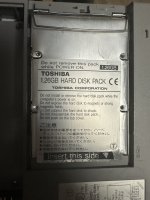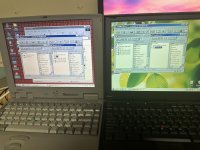Ughhhh. This is all just so incredibly infuriating. I have all these cables, all these laptops, running all these operating systems, and all these tools that I should be able to use to get files over to pre-USB laptops and yet NOTHING works. NOTHING!
I think you are doing something wrong. Serial cables have never failed me, as long as the wiring is correct.
- I try Windows Direct Cable Connection and it won't connect no matter what I do. I followed online tutorials exactly to the letter but it just doesn't work.
One step before the other. Do you actually know that your serial connection works? Don't try fifteen tutorials with twelve cable variants and twenty machines until you know what you are actually trying to do.
- I try the INTERSVR /RCOPY method and the Tecra just locks up after I type the second command it instructs me to type
Yes, this is correct. If you open a terminal program on the connected machine and configure it accordingly ("MODE COM1:2400,N,8,1" means 2400 bps, 8 data bits, 1 stop bit, no parity; "CTTY COM1" means "switch keyboard/screen to COM1"), you should see the DOS prompt on the other machine and be able to use DOS remotely. Also, stuff like "echo abc > COM1" must work correctly.
If that does not work, you have a wiring problem, a hardware problem, or used the wrong port. Your serial cable must be a null modem cable, not a random serial cable. I am not 100% sure whether the hardware handshaking lines must be wired correctly, or whether you can get away with a three-wire interface.
- I try a PCMCIA CF card which ABSOLUTELY SHOULD WORK on Windows 9x and it DOESN'T WORK on ANY of my laptops with Windows 9x. NONE OF THEM! And no one here seems to know how to fix it either!
I replied in your other thread that I think your cards are too big. And at least I only check a few forums and not too regularly.
- Oh and then of course there's the Tecra's CD-ROM drive. It's detected in the BIOS. I can open the disc tray. When I insert a disc, it spins it up and sounds as healthy as can be. But Windows and DOS both act like it isn't there. Why? Who knows! If it worked then I could burn interlnk or LapLink or whatever other tool to a disc and do things that way. But nope.
Well, both Windows and DOS need drivers for the drive to work. For IDE drives, I have used OAKCDROM.SYS from Windows 98 with a very high degree of success (and MSCDEX, of course). Windows 95 (the original version) also had a fun issue where it wouldn't install its own drivers and lose its own installation CD during the installation. Fixed by making sure that the DOS driver works.
I feel like the only thing I have left to try is to try and track down an older version of laplink that can transfer itself over MODE?
Norton Commander 5 can also remote-copy itself over a serial link, similar to INTERSVR. I even had moderate success running the host-side inside DOSBox using a USB-to-serial adapter, but it wasn't too reliable. So use a DOS machine on the other end.
You mentioned lots of laptops. Use one to talk to the other. Make sure communication works.
On DCC - I’ve tried both a LapLink parallel cable and a null modem serial cable. With the serial cable, the computers never detect each other at all… with the parallel they do as mentioned. And yeah they have COM1 and COM2 and I figured one may be infrared so I tried both. No change.
For serial cabling, use a terminal program to verify communication and cabling. Norton Commander comes with TERM95, which is acceptable. CTTY works in a pinch.
On INTERSVR - how long would this take? Because I left it for a couple minutes and the interlink files are tiny. Also did respond to control alt delete during this time
The serial communication process is very slow. Transmissions at 1200 bps are just barely faster than my reading speed. This is done for reliability, because you cannot use a checksumming protocol until you have both sides working correctly. Communication will speed up substantially when things work, but it will be slow. (For comparison, serial communication is limited to either 19.2 kBps or 115.2 kBps depending on driver/interface, and your floppy drives run at 250 or 500 kBps).
On CF - tried seven laptops running 95 OSR 2.5, 98, Me even and all don’t work. Cards formatted as FAT anyway. Adapter and cards work fine on XP and in Mac OS.
The PCMCIA drivers for mass storage are designed for 2 MB SRAM cards. They were never designed for CF cards a thousand times larger.
Thanks for your help. It’s possible my serial cable is junk or something, but I bought it as a null modem cable…
Measure the wiring.


